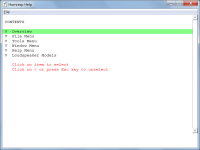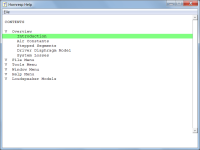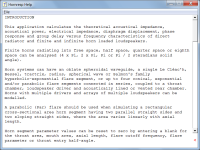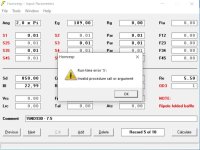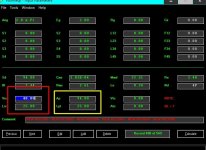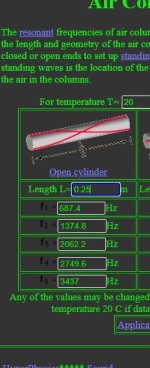All I know, PHYSICALLY, it's NOT an exponential horn since the enclosure has 2 parallel sides.
This

does not look like this (exponential on ALL 4 sides...pyramidal).

This
does not look like this (exponential on ALL 4 sides...pyramidal).
I bet if the the top and bottom sides of the Smith Horn went from 1/16" to 1/4", then there would be a performance gain over the 2 STRAIGHT 1/4" sides.
In BOP racing, they restrict engines (air pumps like subwoofer enclosures) by MM, not CM or IN. So NONE of YOU can tell me going from 1/16" to 1/4" DON'T make a difference.
Like I said before, I don't need to measure a million enclosures or have a PhD in acoustics to know how something SHOULD be modeled versus being BUILT.
So, the last four or five pages or so of this thread are just argumentative discussion over the suggestion that Hornresp should default to assuming PAR segments unless specified otherwise by the user? Wow ... 🙂
If you think the Smith DSH (Distributed Source Horn) exponential expansion diffraction horn "look like a parabolic", you obviously can not tell the difference between those two horn types.This Smith horn look like a parabolic horn.
If the DSH exponential sectors were replaced with straight sheets of plywood, then it would be parabolic.
And using "PAR" rather than "EXP" would then be correct for it's simulation.
I cannot agree.
In that case, you would be wrong!
Bob Smith himself considers it to be an exponential horn in his article published in the January 1951 edition of Audio Engineering:
"Fundamentally the design considerations are the same as those for any exponential horn - i.e, the mouth area must be large enough to prevent reflection at the lowest frequency for which the horn is intended to be used and the rate of taper must be chosen to provide a satisfactory low-frequency cut-off."
For the last time - an acoustic horn is NOT defined by what the "enclosure" may or may not look like, it is defined by how the cross-sectional area of the horn expands with axial length.
Your argument is not even consistent - on one hand you say that a conical horn must look like a physical cone or pyramid, but on the other hand it is okay for a parabolic horn to look nothing like a parabola. In the case of the parabolic horn you are in fact agreeing that it is the linear area expansion rate that defines it.
This is my last post on the matter. If you wish to continue discussing the issue with others, it would be appreciated if you could please do so on another thread.
Amenit would be appreciated if you could please do so on another thread.
Please stop before you get in trouble and we loose you as a member. I enjoy the info you share about tapped pipes and band pass very much.
go start the thread about Terrence Howard and the goofy sacred geometry stuff??
go start the thread about Terrence Howard and the goofy sacred geometry stuff??
Last edited:
 Some of todays posts have been moved to their own thread. This off-topic has outlived it's invitation.
Some of todays posts have been moved to their own thread. This off-topic has outlived it's invitation.Short term thread restrictions are in place. See how easy it is? It's just as easy to make them permanent if a reason should happen along.
Here is the thread - https://www.diyaudio.com/community/...om-hornresp-when-to-use-a-par-segment.412618/
If you wish to continue discussing the issue with others, it would be appreciated if you could please do so on another thread.
Hornresp Update 5600-240518
Hi Everyone,
CHANGE
The operation of the Hornresp Help file has been modified to hopefully make it a little more user friendly. Instead of having a single long scrollable document, items selected from the Contents list are now displayed as stand-alone pages.
The information in the Help file remains the same, and the Find, Export, Print and Close File menu commands work as before.
Kind regards,
David
Hi Everyone,
CHANGE
The operation of the Hornresp Help file has been modified to hopefully make it a little more user friendly. Instead of having a single long scrollable document, items selected from the Contents list are now displayed as stand-alone pages.
The information in the Help file remains the same, and the Find, Export, Print and Close File menu commands work as before.
Kind regards,
David
Attachments
Hi David,
I keep getting a Run-Time error 5 when selecting ripole mode (Tools - Loudspeaker Configuration - Ripole OD3). I noticed when I 'discovered' 😉 ripole mode for the first time, so version 54 - 56.
It happens only when S1, S2, L12 etc. are all at 0,00 or 0,01
Whereas vrc, lrc, fr, tal, vtc and atc can be any number or configuration (so starting from closed, ported or infinite baffle).
After clicking OK, other modes load the input screen as usual, where an error mode might be displayed (like invalid TH data). When selecting Ripole OD 3, pressing OK gives a Run-Time error 5 after which HR crashes.
By the way, that new Help-file operation is a bliss!
I keep getting a Run-Time error 5 when selecting ripole mode (Tools - Loudspeaker Configuration - Ripole OD3). I noticed when I 'discovered' 😉 ripole mode for the first time, so version 54 - 56.
It happens only when S1, S2, L12 etc. are all at 0,00 or 0,01
Whereas vrc, lrc, fr, tal, vtc and atc can be any number or configuration (so starting from closed, ported or infinite baffle).
After clicking OK, other modes load the input screen as usual, where an error mode might be displayed (like invalid TH data). When selecting Ripole OD 3, pressing OK gives a Run-Time error 5 after which HR crashes.
By the way, that new Help-file operation is a bliss!
Attachments
Hi Rademakers,
Thanks for the feedback - it took me a while to identify what was causing the problem...
When the OD3 mode is selected, a number of the input boxes are disabled as shown in the Attachment. If one of those input boxes happens to be highlighted before the OD3 mode is selected (S2 for example), then an error occurs when Hornresp tries to "re-highlight" that same box after it is disabled.
The bug will be fixed in the next update.
In the meantime, just ensure that if an input box is highlighted before the OD3 mode is specified, that it is not one that is disabled afterwards. (It is probably easiest to simply highlight the Ang input box, or alternatively, no box at all).
That is great to hear. I was hoping that people would find the new way of accessing the information a bit easier to use than the old method.
Kind regards,
David
I keep getting a Run-Time error 5 when selecting ripole mode
Thanks for the feedback - it took me a while to identify what was causing the problem...
When the OD3 mode is selected, a number of the input boxes are disabled as shown in the Attachment. If one of those input boxes happens to be highlighted before the OD3 mode is selected (S2 for example), then an error occurs when Hornresp tries to "re-highlight" that same box after it is disabled.
The bug will be fixed in the next update.
In the meantime, just ensure that if an input box is highlighted before the OD3 mode is specified, that it is not one that is disabled afterwards. (It is probably easiest to simply highlight the Ang input box, or alternatively, no box at all).
By the way, that new Help-file operation is a bliss!
That is great to hear. I was hoping that people would find the new way of accessing the information a bit easier to use than the old method.
Kind regards,
David
Attachments
are some of these open pipe resonaces based on the 25cm bass reflex tube(687 and 1374hz). And some are 1/4 resonance based on the overall 50cm/3 (515 hz) ?
Attachments
are some of these open pipe resonaces based on the 25cm bass reflex tube(687 and 1374hz). And some are 1/4 resonance based on the overall 50cm/3 (515 hz) ?
1. Set QL to maximum (lossless).
2. Set Lrc to 0.01 in the Loudspeaker Wizard and vary Lpt to see the effect of Lpt on the response.
3. Set Lpt to 0.01 in the Loudspeaker Wizard and vary Lrc to see the effect of Lrc on the response.
Thanks, lossless mode and matching ‘path‘ to the 25 cm helped to only expose resonaces that were quite easy to identify. 👍🏼. I never realized there could be so many (and based on differevt interval dimension)
Last edited:
With two identical tuned vents with different surface area (in the attached example 37,5cm² and 150cm² on a 10" speaker) on a bassreflex enclosure, all other parameters (including QL) being identical, in the small signal domain (2,83V in this case), Hornresp shows different sensitivities (only talking about the frequency area of the Helmholtz resonator, not the port's own resonances) for the two vents, with the larger vent being louder.
This is in principle correct, as I can testify having done my own extensive empirical research on the subject. But I am curious about your theoretical / mathematical model used in Hornresp for it to arrive at these results.
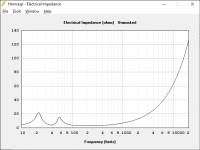
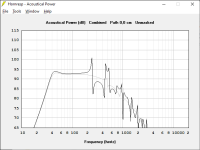
This is in principle correct, as I can testify having done my own extensive empirical research on the subject. But I am curious about your theoretical / mathematical model used in Hornresp for it to arrive at these results.


But I am curious about your theoretical / mathematical model used in Hornresp
Hornresp uses the traditional lumped-element electro-mechano-acoustical equivalent circuit loudspeaker model.
To learn more, Google is your friend...
Just something for people to realize.Hornresp uses the traditional lumped-element electro-mechano-acoustical equivalent circuit loudspeaker model.
It's either that or BEM/FEM.
Sometimes programs put a small empirical spin to it. But that should be still solid and sound with the models we have.
- Home
- Loudspeakers
- Subwoofers
- Hornresp
